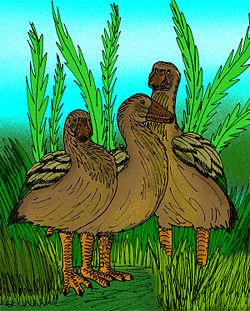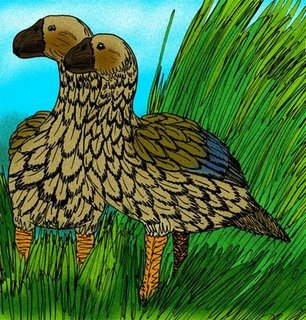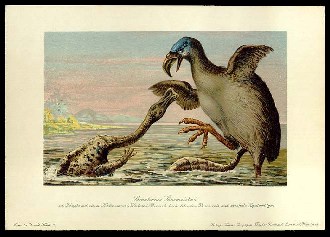June 12, 2008
Artist’s conception of the moa-nalo examples, Thambetochen chauliodous, and Ptaiochen pau. Image by Stanton F. Fink.
Since the dodo was visited here yesterday, our island-hopping journey might as well continue with a view of the Hawaiian flightless birds, the moa-nalo.
Moa-nalo are a group of extinct aberrant, goose-like ducks that formerly lived on the Hawaiian Islands in the Pacific. They were the major herbivores on most of these islands for the last 3 million years or so, until they became extinct after human settlement. (Yes, the storyline sounds familiar.)
The moa-nalo (the name literally means “lost fowl”; an “s” is not added for the plural) were unknown to Science, having been wiped out before the arrival of Captain Cook (1778), until the early 1980s, when their subfossil remains were first discovered in sand dunes on the islands of Molokaʻi and Kauaʻi.
Christopher Taylor in his “Catalogue of Organisms” introduces today, Thursday, June 12, 2008, readers more deeply to his thoughts on the Hawaiian Superducks, the moa-nalo:
Moa-nalo were large (up to 7.6 kg – Ziegler, 2002), flightless goose-like birds that were once found in the Hawaiian Islands, but seem to have not long survived the arrival of hungry humans. To date, four species have been described from various islands (Olson & James, 1991) – Chelychelynechen quassus from Kauai*, Thambetochen xanion from Oahu, T. chauliodous from lowland Maui and Molokai, and Ptaiochen pau from highland Maui.
Moa-nalo are not yet known from the main island of Hawaii, which was home to two species of Branta goose (Paxinos et al., 2002), including the (just) surviving nene (B. sandvicensis). Branta geese were also found on the other Hawaiian islands.
Wetmore (1943) described a fossil anserid species from Hawaii, Geochen rhuax, that he regarded as distinct from Branta (and very like the Australian Cereopsis), but the fragmentary remains this species was described from are not really sufficient to tell whether it is a goose or moa-nalo (or something else again). The unnamed ‘giant Hawaiian goose’ of Olson & James (1991) is quite definitely a Branta (Paxinos et al., 2002).

Reconstruction of Thambetochen xanion. Image by Stanton F. Fink.
Taylor, always the wryly humored taxonomist then shares a couple insider jokes about the specimen remains of the moa-nalo, but you’ll have to travel to his blog, here, to read them. I won’t want to spoil his fun. Then Taylor says some things about one of his apparent first loves, the systematics of these birds:
Perhaps most interesting about the moa-nalo is their phylogenetic relationships (isn’t it always?). Despite their goose-like appearance, Olson & James (1991) suggested on the basis of their ossified syringeal bullae that moa-nalo were actually more closely related to the dabbling ducks of the genus Anas (two species of which are also found on Hawaii), and possibly even derived from the common mallard (A. platyrhynchos). This view was corroborated to some extent by ancient DNA analysis (Sorenson et al., 1999) which, while it found the moa-nalo as the sister group to Anas rather than within it, definitely indicated a duck rather than goose ancestry for them.

The turtle-jawed moa-nalo, Chelychelynechen quassus, largest of this group of birds. Image by Stanton F. Fink.

Interesting also in Taylor’s blog today is his tip of the hat to our old cryptofriendly buddy Darren Naish and his new Tetrapod Zoology blog of June 10th about both the giant carnivorous birds that once stalked South America and the megaducks.
I’ve not discovered any figurine replicas of moa-nola, to date, but I’ll have to ask Darren about them. Our shared interest in replicas of fossil and modern animals tells me that if anyone knows, it would be Darren.
About Loren Coleman
Loren Coleman is one of the world’s leading cryptozoologists, some say “the” leading living cryptozoologist. Certainly, he is acknowledged as the current living American researcher and writer who has most popularized cryptozoology in the late 20th and early 21st centuries.
Starting his fieldwork and investigations in 1960, after traveling and trekking extensively in pursuit of cryptozoological mysteries, Coleman began writing to share his experiences in 1969. An honorary member of Ivan T. Sanderson’s Society for the Investigation of the Unexplained in the 1970s, Coleman has been bestowed with similar honorary memberships of the North Idaho College Cryptozoology Club in 1983, and in subsequent years, that of the British Columbia Scientific Cryptozoology Club, CryptoSafari International, and other international organizations. He was also a Life Member and Benefactor of the International Society of Cryptozoology (now-defunct).
Loren Coleman’s daily blog, as a member of the Cryptomundo Team, served as an ongoing avenue of communication for the ever-growing body of cryptozoo news from 2005 through 2013. He returned as an infrequent contributor beginning Halloween week of 2015.
Coleman is the founder in 2003, and current director of the International Cryptozoology Museum in Portland, Maine.
Filed under Breaking News, Cryptomundo Exclusive, Cryptotourism, CryptoZoo News, Cryptozoologists, Cryptozoology, Extinct, Fossil Finds, Megafauna, Men in Cryptozoology, Replica Cryptia